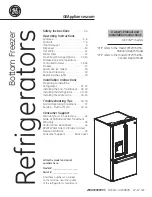
- 12 -
Hints for fresh food refrigeration
•
Do not place hot food directly into the refrigerator or freezer, the internal temperature will increase
resulting in the compressor having to work harder and will consume more energy.
•
Do cover or wrap the food, particularly if it has a strong flavor.
•
Place food properly so that air can circulate freely around it.
Hints for refrigerator
•
Meat (All Types) Wrap in polythene food: wrap and place on the glass shelf above the vegetable drawer.
Always follow food storage times and use by dates suggested by manufacturers.
•
Cooked food, cold dishes, etc.: They should be covered and may be placed on any shelf.
•
Fruit and vegetables: They should be stored in the special drawer provided.
•
Butter and cheese: Should be wrapped in airtight foil or plastic film wrap.
•
Milk bottles: Should have a lid and be stored in the door racks.
Hints for freezing
•
When first starting-up or after a period out of use, let the appliance run at least 2 hours on the higher settings
before putting food in the compartment.
•
Prepare food in small portions to enable it to be rapidly and completely frozen and to make it possible to
subsequently thaw only the quantity required.
•
Wrap up the food in aluminum foil or polyethylene food wraps which are airtight.
•
Do not allow fresh, unfrozen food to touch the food which is already frozen to avoid temperature rise of the
latter.
•
Iced products, if consumed immediately after removal from the freezer compartment, will probably cause
frost burns to the skin.
•
It is recommended to label and date each frozen package in order to keep track of the storage time.
Hints for the storage of frozen food
•
Ensure that frozen food has been stored correctly by the food retailer.
•
Once defrosted, food will deteriorate rapidly and should not be re-frozen. Do not exceed the storage period
indicated by the food manufacturer.
Switching off your appliance
If the appliance needs to be switched off for an extended period, the following steps should be taken to prevent
mould on the appliance.
1.
Remove all food;
2.
Remove the power plug from the mains socket;
3.
Clean and dry the interior thoroughly;
4.
Ensure that all the doors are wedged open slightly to allow air to circulate.
CLEANING AND CARE
For hygienic reasons the appliance (including exterior and interior accessories) should be cleaned regularly at
least every two months.
WARNING:
The appliance must not be connected to the mains during cleaning. Danger of electrical shock!
Before cleaning, switch the appliance off and remove the plug from the mains socket.
Exterior cleaning
•
To maintain good appearance of your appliance, you should clean it regularly.
•
Wipe the digital panel and display panel with a clean, soft cloth.
•
Spray water onto the cleaning cloth instead of spraying directly on the surface of the appliance. This helps
ensure an even distribution of moisture to the surface.
•
Clean the doors, handles and cabinet surfaces with a mild detergent and then wiped dry with a soft cloth.
Caution!
Don't use sharp objects as they are likely to scratch the surface.
Don’t use Thinner, Car detergent, Clorox,
ethereal oil, abrasive cleansers or organic solvent such as Benzene for cleaning. They may damage the surface
of the appliance and may cause fire.
Summary of Contents for SBS-125596.1
Page 1: ......














































